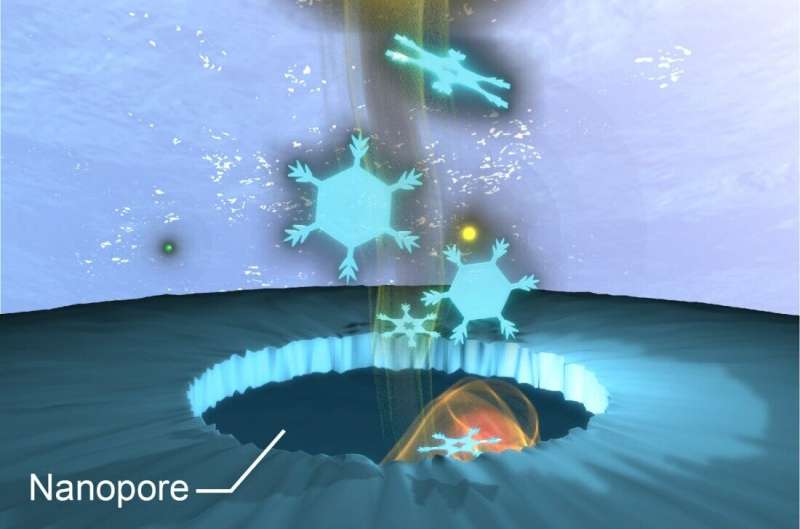
Researchers from Osaka University investigated the thermal energy changes across nanopores that allow the selective flow of ions. Switching off the flow of ions in one direction led to a cooling effect. The findings have applications in nanofluidic devices and provide insight into the factors governing ion channels in cells. The nanopore material could be tailored to tune the cooling and arrays could be produced to scale up the effect.
Have you ever wondered how water boils in an electric kettle? Most people may think electricity simply heats up the metal coil inside the kettle, which then transfers the heat to the water. But electricity can do more than that. Heat can be generated when electricity makes ions in solution flow. When all the ions and surrounding molecules can move freely, this heating effect is evened out across the whole solution. Now researchers from Japan have investigated what happens when this flow is blocked in one direction.
In a study published in Device, the team led by researchers from SANKEN (The Institute of Scientific and Industrial Research), Osaka University has shown that it is possible to achieve cooling by using a nanopore—a very small hole in a membrane—as a gateway that only allows certain ions through.
In general, using electricity to drive ions in solutions draws positively charged ions and negatively charged ions in opposite directions. So, the heat energy carried by the ions travels both ways.
If the path of the ions is obstructed by a membrane with only a nanopore to get through, then it becomes possible to control the flow. For example, if the pore surface is negatively charged, then the negative ions can interact with it rather than pass through, and only the positive ions will flow, taking their energy with them.
“At high ion concentrations we measured an increase in temperature as the electrical power was increased,” explains study lead author Makusu Tsutsui. “However, at low concentrations the available negative ions interacted with the negatively charged nanopore wall. Therefore, only positively charged ions passed through the nanopore and a decrease in temperature was observed.”
The ionic refrigeration that was demonstrated could be used for cooling in microfluidic systems—setups that are used to move, mix, or investigate very small volumes of liquids. Such systems are important across many disciplines from microelectronics to nanomedicine.
In addition, the findings could help further the understanding of ion channels, which play crucial roles in the finely balanced machinery of cells. Such insight could be key to understanding function and disease, as well as designing treatments.
“We are excited by the breadth of the potential impact of our findings,” says study senior author Tomoji Kawai. “There is considerable scope for the nanopore material to be tailored to tune the cooling. In addition, arrays of nanopores could be created to amplify the effect.”
The list of areas that could be enhanced by the findings is indeed considerable and extends to using a temperature gradient to generate electric potential. This could be applied for temperature sensing or in blue energy harvesting.
More information:
Makusu Tsutsui et al, Peltier cooling for thermal management in nanofluidic devices, Device (2023). DOI: 10.1016/j.device.2023.100188
Journal information:Device
Provided by
Osaka University

READ MORE
Researchers develop a new way to identify bacteria in fluids
(a) Schematic of acoustic printing platform and confocal Raman setup. Droplets containing bacteria (purple) and [...]
Why Everybody Is Hooked on Fish Sauce
Fish sauce is a traditional ingredient in both Vietnamese and Thai cuisines. Here a bowl [...]
Dying stars could seed interstellar medium with carbon nanotubes
In this picture of the Spirograph Nebula, a dying star about 2,000 light-years from Earth, [...]
Chameleons inspire new multicolor 3D-printing technology
Inspired by the color-changing abilities of chameleons, researchers developed a dynamic and sustainable color-changing ink [...]
People Drink 47% More With an Open Bar, Study Says
The availability of an open bar at an event has the potential to alter a [...]
Chemists develop ferromagnetic single-atom spin catalyst for boosting water splitting reactions
(Left) Illustration of the hydrothermal synthesis of M1/MoS2 single-atom spin catalysts (SASCs) under acidic conditions [...]
How long does alcohol stay in your system?
The standard rate that the human liver can metabolize alcohol? One ounce per hour. Christian [...]
Rita Rapp Fed America’s Space Travelers
Jennifer Levasseur from the National Air and Space Museum notes that the museum’s supply of [...]